For many dog lovers, the dream of a furry companion can often be complicated by allergies or the constant battle against pet hair. While no dog is truly 100% “hypoallergenic,” certain dog breeds that don’t shed as much can significantly reduce allergens in your home and make life easier for allergy sufferers. Understanding which breeds fall into this category and what makes them unique is the first step towards finding your perfect canine match. This guide will delve into the world of low-shedding dogs, offering insights into their characteristics, care needs, and why they might be the ideal choice for you.
Living with a dog doesn’t have to mean living with a constant layer of pet hair on your furniture and clothes. Many individuals find relief with certain breeds, often referred to as “hypoallergenic,” which produce less dander and shed minimal hair. These qualities are a game-changer for people seeking to enjoy the companionship of a dog without the common drawbacks associated with excessive shedding. Whether you’re a first-time owner or looking to add another member to your family, exploring dog breeds that don’t shed as much opens up a world of possibilities for a cleaner, happier home and fewer allergy symptoms. If you’re specifically looking for [small dog types that don't shed](https://dogcarestory.com/small-dog-types-that-don-t-shed/), there are numerous excellent choices that combine a compact size with a low-shedding coat.
Understanding “Hypoallergenic” Dogs and Shedding
The term “hypoallergenic” is often misunderstood when it comes to dogs. All dogs produce allergens, primarily through dander (dead skin cells), saliva, and urine, not just their hair. However, dog breeds that don’t shed as much tend to release fewer allergens into the environment because their hair doesn’t fall out as frequently, trapping dander against their skin rather than dispersing it. This means less loose hair and dander floating around your home, which can significantly alleviate allergic reactions for sensitive individuals.
It is crucial to remember that “hypoallergenic” does not mean “allergen-free.” An allergic response can still occur from skin flakes, saliva left on toys, or even urine. Therefore, managing allergies also involves regular grooming, diligent cleaning, and sometimes medical consultation. For individuals with severe allergies, spending time with a specific breed before committing to adoption is always recommended to assess potential reactions. The goal is to find a dog that minimizes allergen exposure rather than eliminating it entirely.
Top Dog Breeds That Don’t Shed As Much
Here is a comprehensive list of dog breeds known for their low shedding coats, making them excellent choices for those seeking a cleaner home or struggling with allergies. Each breed offers a unique combination of temperament, size, and grooming needs.
1. Poodle
Poodles are perhaps the most well-known of the dog breeds that don’t shed as much. Available in three sizes—Standard, Miniature, and Toy—they are highly intelligent and boast a dense, curly coat that sheds minimally. This coat requires regular grooming, including brushing to prevent matting and professional clipping every 4-6 weeks, but the payoff is a significantly reduced amount of dander and loose hair. Standard Poodles were historically water retrievers, showcasing their athleticism, while their smaller counterparts were bred for companionship. If you are interested in a [red Miniature Poodle for sale](https://dogcarestory.com/red-miniature-poodle-for-sale-near-me/), these intelligent dogs offer both beauty and brains.
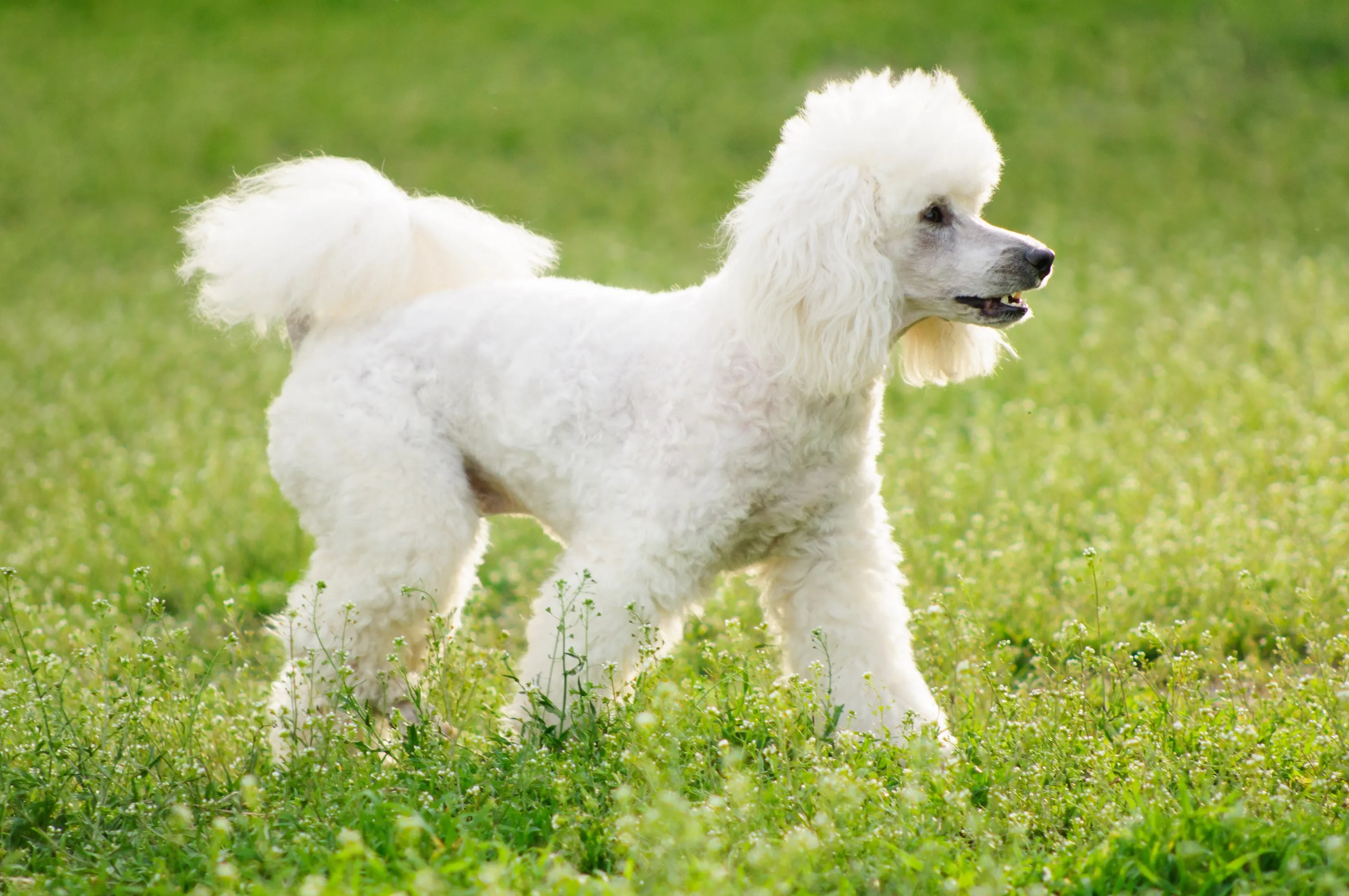 White Poodle walking through grass
White Poodle walking through grass
2. Yorkshire Terrier
Known for their long, silky, human-like hair, Yorkshire Terriers are small dogs with big personalities that are another excellent choice among dog breeds that don’t shed as much. Their fine coat sheds very little, making them suitable for many allergy sufferers. Yorkies are adaptable and can thrive in various living environments, from apartments to larger homes, provided they receive ample attention and companionship. Regular brushing is essential to keep their long coats tangle-free and shiny.
3. Shih Tzu
The Shih Tzu is an ancient companion breed with a flowing double coat that sheds minimally, especially when kept well-groomed. These friendly and affectionate small dogs are famous for their charming temperament. However, due to their brachycephalic (flat) faces, they can be prone to certain health issues like overheating and breathing difficulties. Their long hair around the eyes also necessitates daily cleaning to prevent tear stains. Despite these considerations, their low-shedding nature makes them popular.
 Brown and white Shih Tzu lying on a living room floor
Brown and white Shih Tzu lying on a living room floor
4. Miniature Schnauzer
Miniature Schnauzers are sturdy, smart, and spirited dogs with a wiry outer coat and soft undercoat that sheds very little. They are compact in size, typically weighing between 10-20 pounds, and fit well into various lifestyles. These alert and playful dogs require daily exercise and benefit from mental stimulation. Their distinctive facial hair, including eyebrows and beard, needs regular maintenance.
5. Standard Schnauzer
The Standard Schnauzer is the medium-sized version of the Schnauzer family, possessing the same low-shedding, wiry coat as its miniature counterpart. These dogs are robust, intelligent, and highly active, needing significant daily exercise and engagement. They share the Miniature Schnauzer’s distinctive appearance and loyal personality, making them excellent family protectors and companions for active households.
 Gray Standard Schnauzer standing in a field
Gray Standard Schnauzer standing in a field
6. Giant Schnauzer
As the largest of the Schnauzer breeds, Giant Schnauzers are powerful, imposing dogs with a low-shedding, dense, wiry coat. They require substantial exercise and mental challenges to keep them happy and well-behaved. Their intelligent and protective nature makes them excellent guard dogs and devoted family members. Proper training and early socialization are crucial for these large, energetic dogs.
7. Bichon Frise
The Bichon Frise is a cheerful, affectionate, and playful small dog with a fluffy, curly white coat that is among the dog breeds that don’t shed as much. Their coat sheds very little, making them a top choice for allergy sufferers. Bichons are highly trainable and intelligent, excelling in obedience and tricks with positive reinforcement. Their happy-go-lucky demeanor makes them wonderful companions for families.
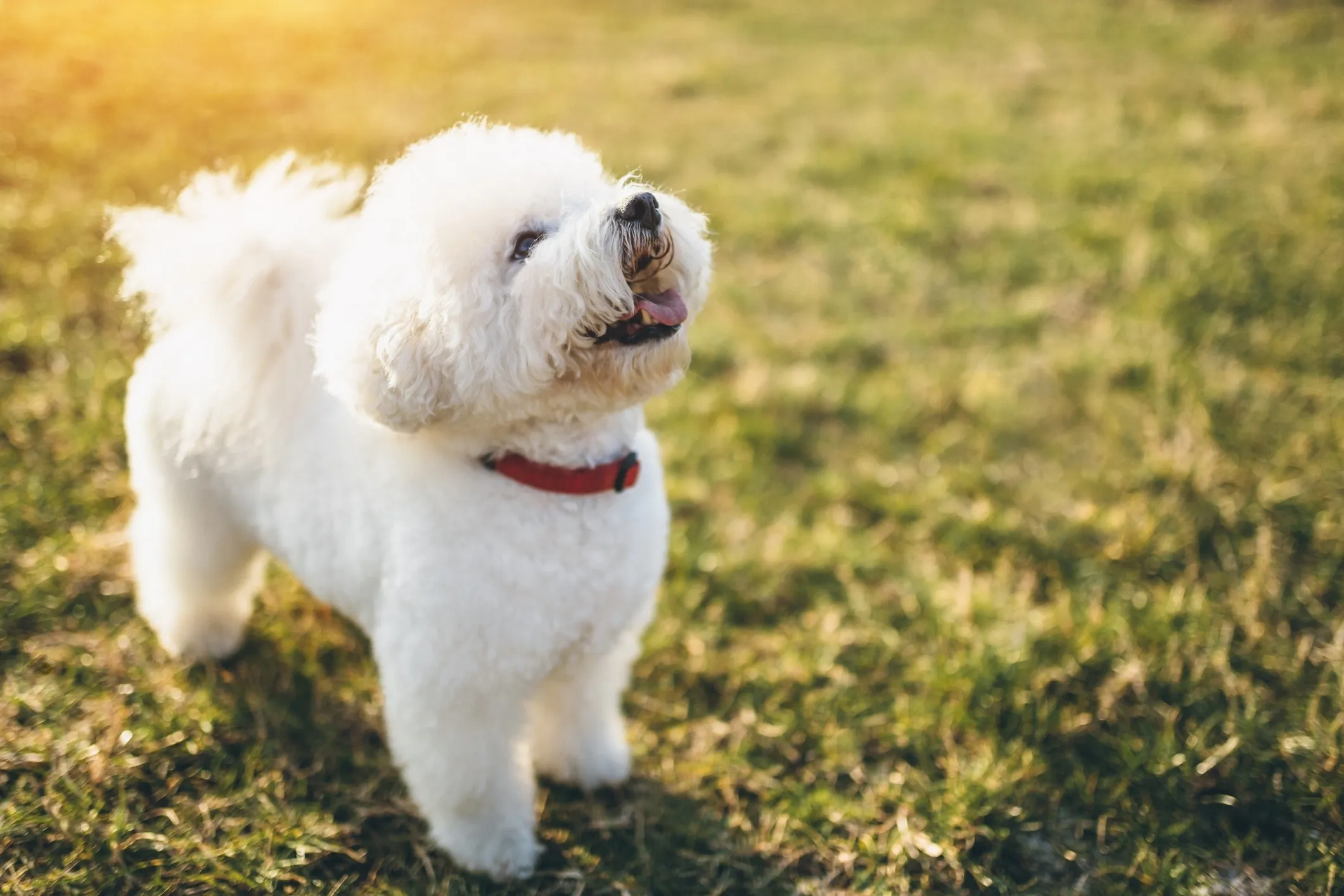 White Bichon Frise dog looking up in the grass
White Bichon Frise dog looking up in the grass
8. Chinese Crested
The Chinese Crested is known for its unique appearance, coming in two varieties: hairless and “powderpuff.” Both are considered dog breeds that don’t shed as much. The hairless variety has smooth skin with tufts of hair on the head, tail, and paws, while the powderpuff has a full, soft coat. Both are playful, affectionate, and thrive on companionship. The hairless variety requires skin care, while the powderpuff needs regular grooming to prevent matting.
9. Portuguese Water Dog
Originally bred to assist fishermen, the Portuguese Water Dog is a medium-sized, robust breed with a thick, curly, waterproof coat that sheds minimally. These dogs are highly intelligent, energetic, and eager to please, making them very trainable. They love to swim and require significant daily exercise to keep them physically and mentally stimulated. Their playful nature makes them great companions for active families.
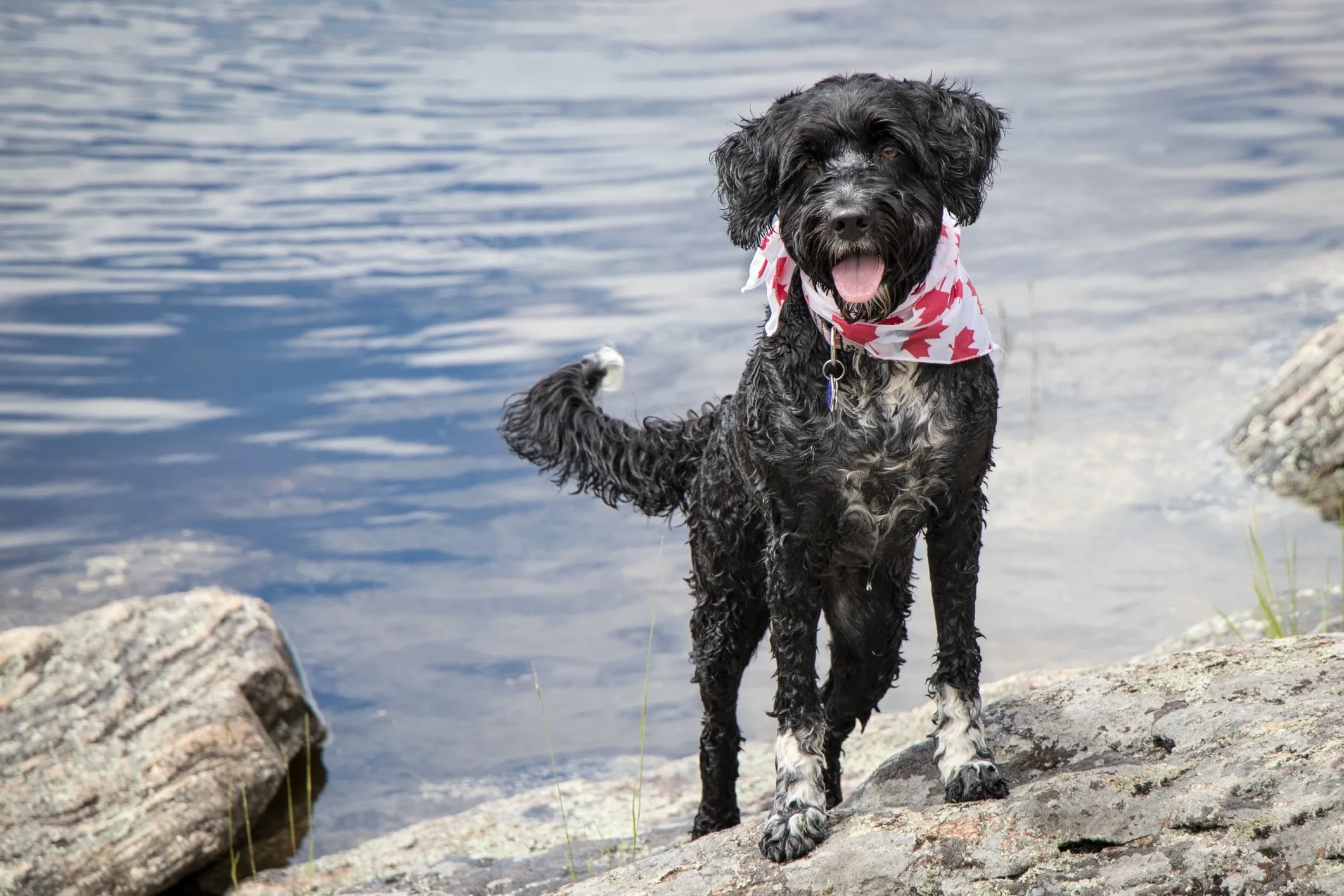 Black and white Portuguese Water Dog wearing a red maple leaf bandana in front of water
Black and white Portuguese Water Dog wearing a red maple leaf bandana in front of water
10. Labradoodle
A crossbreed between a Labrador Retriever and a Poodle, the Labradoodle was initially bred as a low-shedding service dog. Their coats can vary from wavy to curly, and they are generally considered dog breeds that don’t shed as much, though shedding can depend on the coat type inherited. Labradoodles are intelligent, friendly, and make excellent family pets, known for their gentle nature and high trainability, especially with early socialization. Considering a [Toy Labradoodle puppy](https://dogcarestory.com/toy-labradoodle-puppies-for-sale-near-me/) could be an ideal choice for a smaller living space.
11. Goldendoodle
Another popular “doodle” breed, the Goldendoodle is a cross between a Golden Retriever and a Poodle. Like Labradoodles, their shedding level depends on their coat type, but many are low-shedding. Goldendoodles are renowned for their friendly, affectionate nature and high intelligence, making them wonderful family dogs. Their coats come in various colors and textures and require frequent grooming to prevent matting.
 Goldendoodle lying on a couch with a person sitting in the background
Goldendoodle lying on a couch with a person sitting in the background
12. Lagotto Romagnolo
The Lagotto Romagnolo is an ancient Italian breed originally used as water retrievers and truffle hunters. They possess a dense, curly, woolly coat that is waterproof and sheds minimally. Lagotti are intelligent, active, and affectionate dogs that are typically good with children and other pets, making them great family additions for those seeking dog breeds that don’t shed as much.
13. Affenpinscher
Affenpinschers are small, charming dogs known for their monkey-like expressions. Their dense, wiry coat sheds very little, making them a good option for allergy sufferers. While low-shedding, their coat requires diligent care, including regular brushing and occasional hand-stripping to maintain its texture and prevent matting. These dogs are confident, curious, and make lively companions.
 Black Affenpinscher dog close-up
Black Affenpinscher dog close-up
14. Irish Water Spaniel
The Irish Water Spaniel is a distinctive, intelligent, and energetic breed with a dense, curly, waterproof coat that sheds minimally. These friendly dogs were bred for retrieving game from water and require significant daily exercise to satisfy their high energy levels. Their liver-colored coat needs regular grooming to prevent tangles and mats.
15. Aussiedoodle
A cross between an Australian Shepherd and a Poodle, the Aussiedoodle is a highly intelligent and energetic dog that typically falls into the category of dog breeds that don’t shed as much. Their coats can be wavy or curly, requiring regular grooming. Aussiedoodles thrive on activity and mental stimulation; without enough, they can become bored and destructive. They are affectionate and eager to please, making them fantastic companions for active families. For those interested in [mini Australian Shepherd puppies for sale](https://dogcarestory.com/cheap-mini-australian-shepherd-puppies-for-sale/), the Aussiedoodle offers a low-shedding alternative.
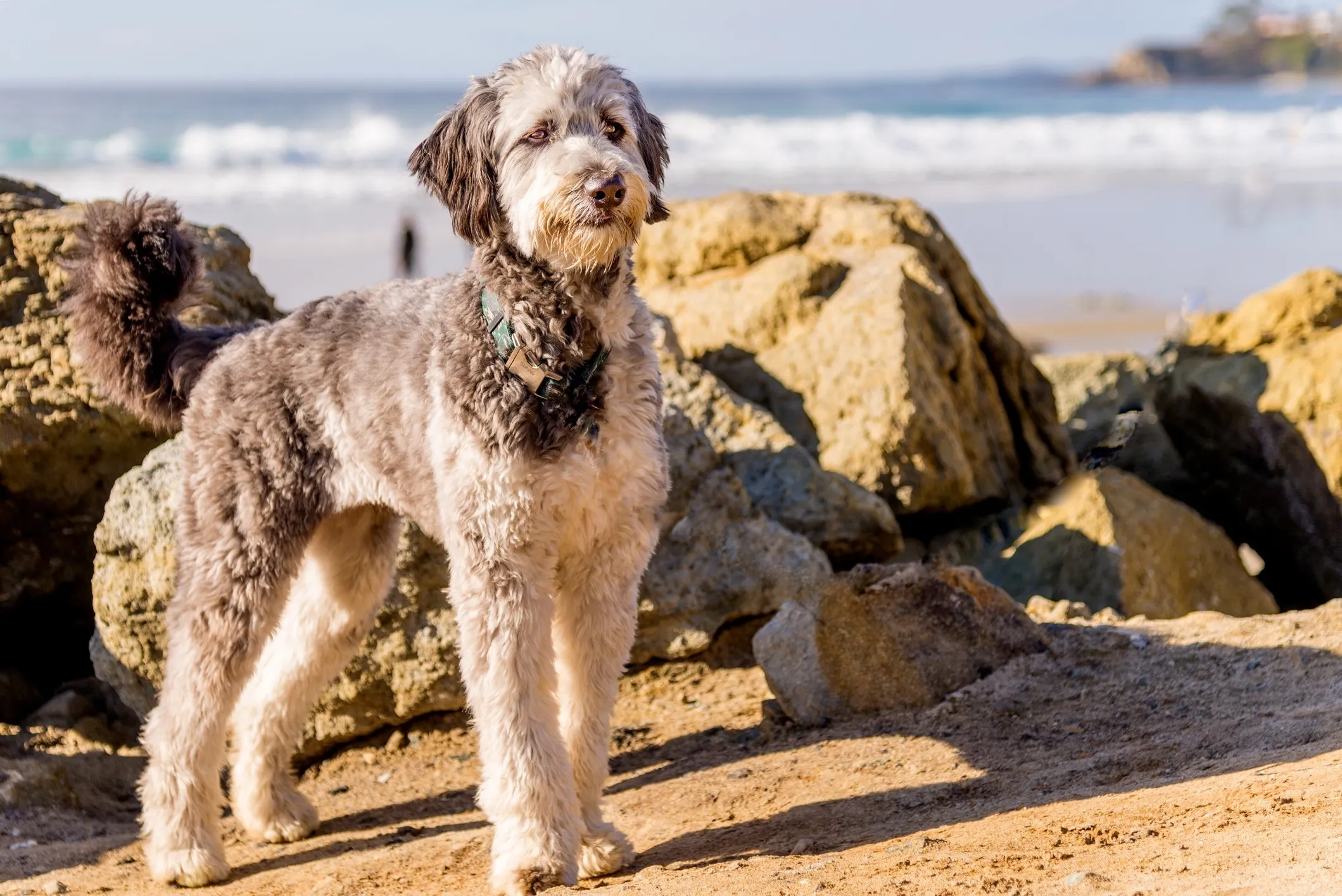 Standard Aussiedoodle dog standing on a beach
Standard Aussiedoodle dog standing on a beach
16. Bolognese
The Bolognese is a small, charming dog with a long, fluffy white coat that, despite its appearance, sheds very little. Originating in Italy, these playful and easygoing pups are known for getting along well with children and other pets. Their distinctive coat requires regular grooming to keep it clean and tangle-free. Bolognese adapt well to various living situations, making them versatile companions.
17. Maltese
Known for their luxurious, long white coat, Maltese are among the most popular small dog breeds that don’t shed as much. They are affectionate, playful, and thrive on human companionship. Their single-layer coat requires extensive grooming to prevent matting, especially if kept long. Many owners opt for a shorter “puppy cut” to simplify care.
 Woman holding a white Maltese dog on a bed
Woman holding a white Maltese dog on a bed
18. Soft Coated Wheaten Terrier
The Soft Coated Wheaten Terrier is a medium-sized Irish breed known for its silky, soft, wheat-colored coat that sheds minimally. These terriers maintain a high energy level throughout their lives and require ample exercise and mental stimulation to prevent boredom and destructive behaviors. They are friendly, joyful, and make devoted family members.
19. Coton de Tulear
Originating in Madagascar, the Coton de Tulear is a small, easygoing breed with a soft, cotton-like coat that is low-shedding. Cotons are known for their charming personalities, playful nature, and adaptability. They generally get along well with children and other pets, making them excellent family companions. Their distinctive coat needs regular brushing to prevent tangles.
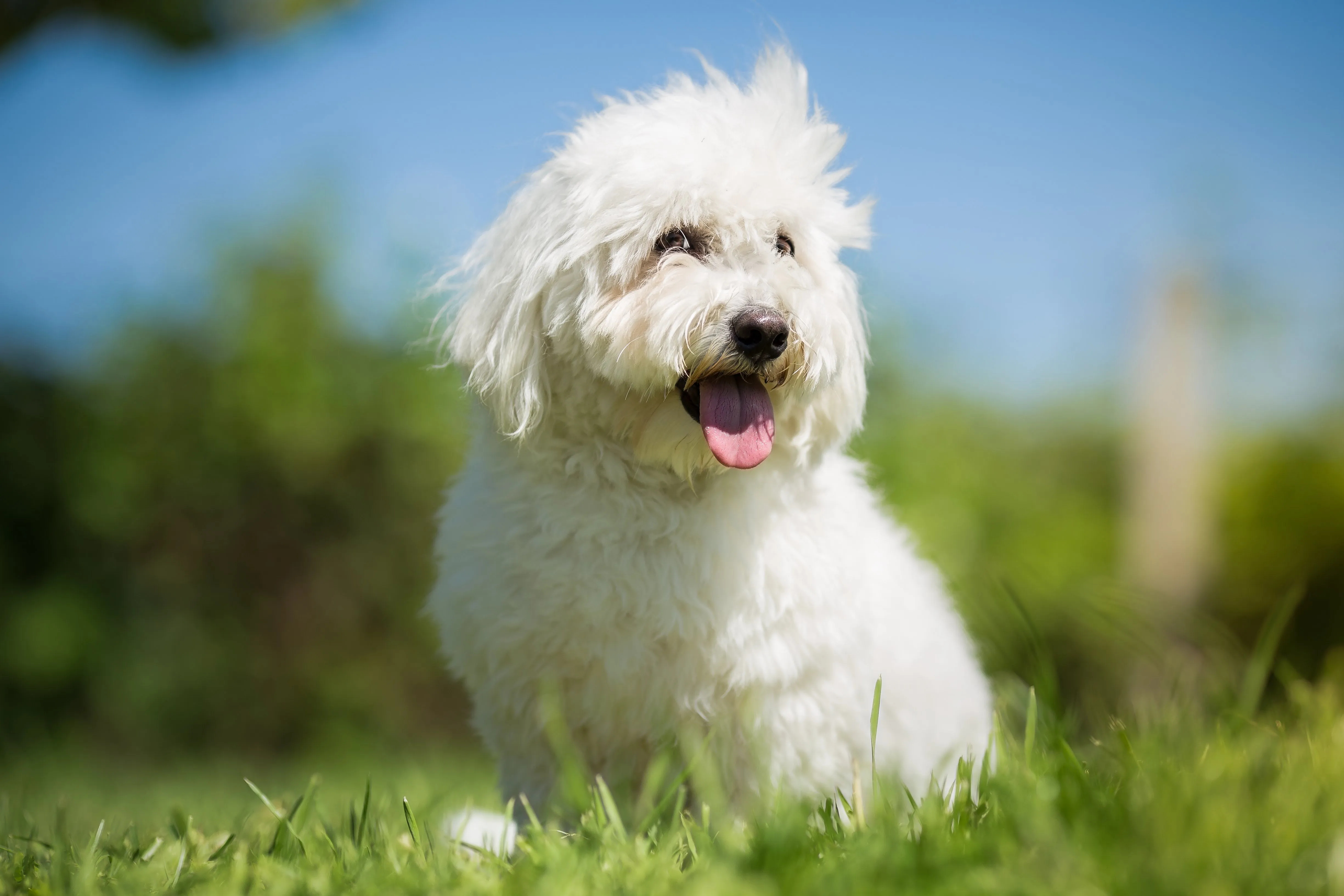 White Coton de Tulear sitting in grass with hair blowing in the wind
White Coton de Tulear sitting in grass with hair blowing in the wind
20. Schnoodle
The Schnoodle is a hybrid of two low-shedding breeds: the Schnauzer and the Poodle. This combination results in a dog with a coat that is typically wavy or curly and sheds very little. Schnoodles inherit intelligence and a playful nature from both parents, making them adaptable and charming companions. Their grooming needs will vary depending on their specific coat type. For those seeking [small Poodle mix puppies](https://dogcarestory.com/small-poodle-mix-puppies-for-sale-near-me/) that combine intelligence and a low-shedding coat, the Schnoodle is a fantastic option.
21. Bedlington Terrier
Often described as a “lamb in dog’s clothing,” the Bedlington Terrier has a distinctive woolly, curly coat that sheds very little. These small dogs are known for their unique appearance, including a topknot hairdo. Bedlingtons are affectionate and thrive on human companionship; they can be prone to separation anxiety if left alone for extended periods. They require regular grooming to maintain their unique coat.
 White Bedlington Terrier running through snow
White Bedlington Terrier running through snow
22. Xoloitzcuintli (Mexican Hairless Dog)
The Xoloitzcuintli, or Mexican Hairless Dog, is an ancient and rare breed that comes in hairless and coated varieties, both considered among dog breeds that don’t shed as much. The hairless variety is virtually shed-free, while the coated variety has a short, smooth coat that sheds minimally. Xolos are known for their calm, alert, and loyal nature, making them excellent companions for those seeking a unique and low-maintenance grooming dog.
23. Whoodle
A cross between a Soft Coated Wheaten Terrier and a Poodle, the Whoodle is a friendly, intelligent dog with a soft, wavy to curly coat that sheds very little. They inherit affectionate natures from both parent breeds and are known for their playful and outgoing personalities. Whoodles make wonderful family pets and are adaptable to various living situations, provided they receive enough exercise and attention.
 Tan Whoodle puppy dragging a wash cloth
Tan Whoodle puppy dragging a wash cloth
24. Bernedoodle
The Bernedoodle is a crossbreed of a Bernese Mountain Dog and a Poodle, offering a gentle, affectionate, and low-shedding companion. Their coat types can vary, but many Bernedoodles have wavy or curly coats that shed minimally. These large, friendly dogs are popular family pets due to their patient demeanor and intelligence, though they require regular exercise to stay happy and healthy.
25. Shorkie
The Shorkie is a delightful mix of two low-shedding breeds: the Shih Tzu and the Yorkshire Terrier. This mixed breed combines the best traits of both, resulting in a small, playful, and friendly dog with a coat that sheds very little. Shorkies are affectionate lapdogs that require consistent grooming to keep their long, silky coats free of tangles and mats.
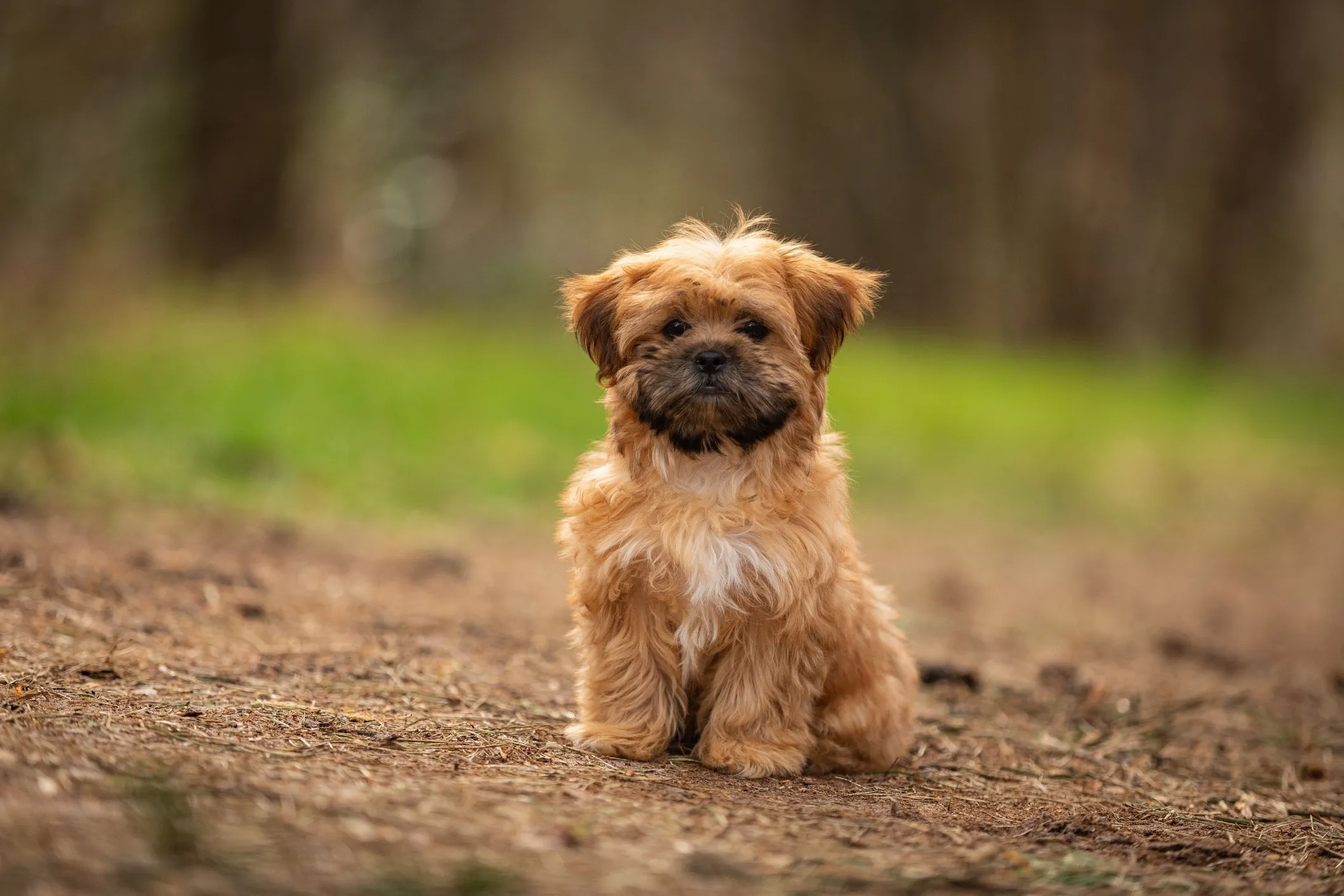 Tan and black Shih Tzu and Yorkie mix sitting on a hiking trail
Tan and black Shih Tzu and Yorkie mix sitting on a hiking trail
26. Afghan Hound
Afghan Hounds are striking dogs known for their elegant, flowing coats and aristocratic appearance. Despite their long hair, they are considered dog breeds that don’t shed as much because their coat has a unique texture that sheds more like human hair than typical dog fur. These sighthounds are built for speed and require ample exercise. They are loving with their families but can be aloof with strangers, necessitating early and consistent socialization.
27. Barbet
The Barbet, pronounced “bar-bay,” is a cheerful and shaggy water dog with a dense, woolly, curly coat that is low-shedding and waterproof. Their name, derived from the French word “barbe” (beard), refers to their characteristic facial hair. Barbets love to swim and require regular grooming, including brushing two to three times a week, to keep their protective coat in good condition. They are intelligent and friendly, making them great companions for active families.
 Close-up of a curly red Barbet dog face
Close-up of a curly red Barbet dog face
28. Shih-Poo
A Shih-Poo is a charming cross between a Shih Tzu and a Poodle, usually a Toy Poodle. This mixed breed is small, adaptable, and typically low-shedding, inheriting desirable traits from both parents. Shih-Poos can thrive in almost any living situation, as long as they receive about 30 minutes of daily exercise and consistent brushing to maintain their coat. They are affectionate and intelligent, making them wonderful lap companions.
29. Peruvian Inca Orchid
The Peruvian Inca Orchid is a rare, ancient breed that comes in three sizes and is mostly hairless, making it an excellent choice for those seeking dog breeds that don’t shed as much. While some coated varieties exist with short hair, the hairless type is the most common and sheds almost none. These dogs are noble, alert, and protective, making devoted companions. Their hairless skin requires sun protection and moisturizing.
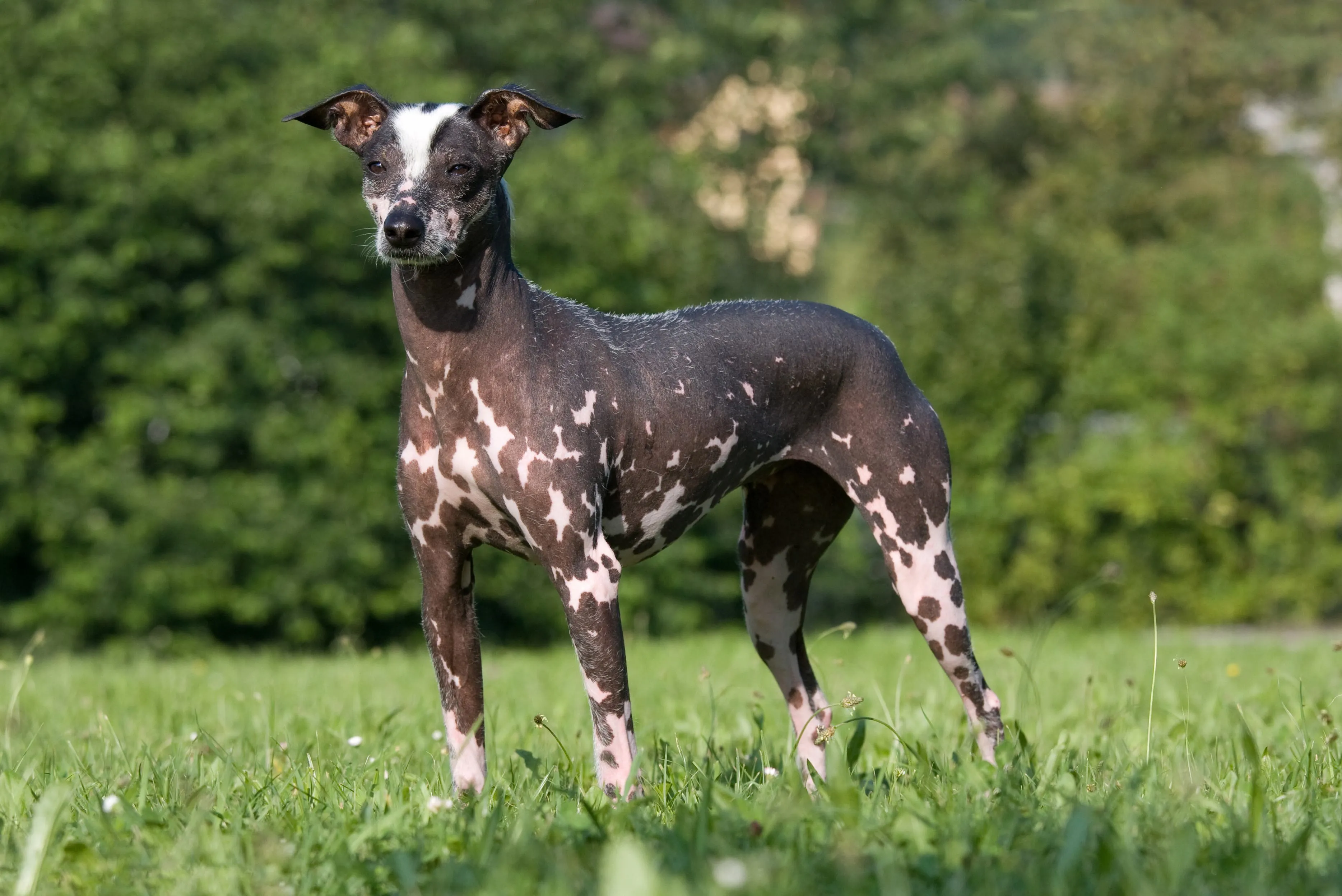 Peruvian Inca Orchid dog
Peruvian Inca Orchid dog
30. Malshi
The Malshi is a delightful cross between a Maltese and a Shih Tzu, resulting in a small, happy, and low-shedding dog. Malshis thrive on companionship and are known for their affectionate and playful personalities. Like most low-shedding breeds with longer coats, they require a regular grooming routine to prevent matting and keep their fur in top condition.
Essential Tips for Living with a Low-Shedding Dog
Even with dog breeds that don’t shed as much, managing allergens and maintaining a clean home requires consistent effort. Here are some key tips:
Keep Up With Grooming
Regular grooming is paramount for low-shedding dogs. Their coats, while not shedding much, can trap dander and require frequent attention to prevent matting and keep them healthy.
- Brushing: Daily or every-other-day brushing is often necessary, especially for breeds with long or curly coats. This helps remove loose hair and dander, preventing it from accumulating in your home.
- Bathing: Bathe your dog every four to six weeks using a gentle, veterinarian-approved shampoo. Some specialized shampoos, like dander removers, can help further reduce allergens.
- Professional Grooming: Many low-shedding breeds require regular professional trimming or hand-stripping to maintain their coat health and structure. Budget for these services or learn how to groom your dog at home safely.
Maintain a Clean Home
Minimizing allergens in your living environment is crucial for allergy sufferers.
- Regular Cleaning: Vacuum frequently with a HEPA-filtered vacuum cleaner, dust surfaces regularly, and wash bedding (both yours and your dog’s) in hot water.
- Air Purification: Consider using air purifiers with HEPA filters in main living areas and bedrooms to capture airborne allergens.
- Designated Dog Areas: Create specific areas in your home where your dog spends most of its time, and limit access to bedrooms to reduce allergen exposure while you sleep.
Consult Your Healthcare Provider
If you or a family member suffer from allergies, consult a healthcare professional to develop a comprehensive allergy management plan.
- Allergy Management: Your doctor can recommend various treatments, including antihistamines, nasal sprays, or allergy shots (immunotherapy), to help manage symptoms.
- Understanding Allergens: Remember that allergens are found in dander, saliva, and urine. Avoid close contact with your dog’s saliva, such as allowing them to lick your face, and ensure proper hygiene after handling them or cleaning up messes.
Bringing home a dog that doesn’t shed as much can dramatically enhance the quality of life for individuals with allergies, allowing them to experience the profound joy and companionship that only a pet can provide. By understanding the nuances of “hypoallergenic” breeds and committing to a consistent routine of grooming and home maintenance, you can create a harmonious environment for both you and your furry friend.
Written by: Nicole Zittritsch, LVT, BSc, MPH, Veterinarian Technician
